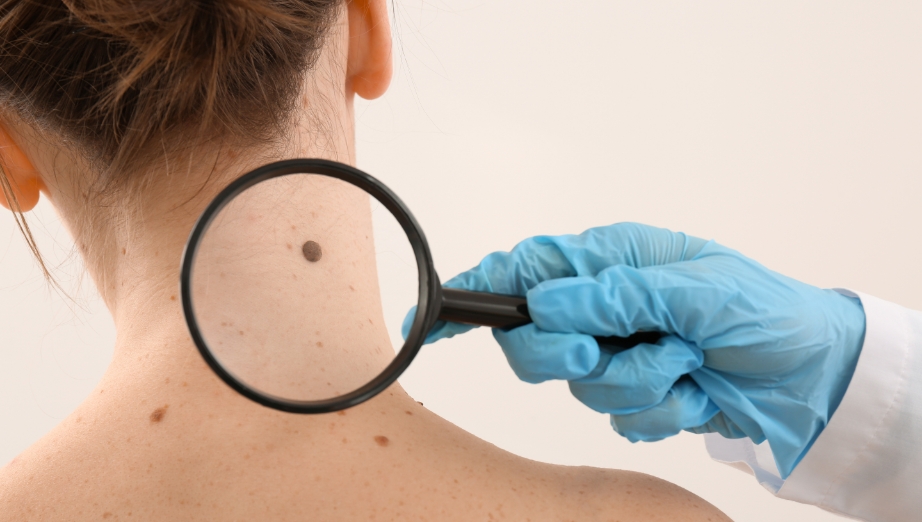Melanoma: Understanding a Serious Form of Skin Cancer
Melanoma is a form of skin cancer that originates in the pigment-producing cells known as melanocytes. It is considered one of the more serious types of skin cancer because it has the potential to spread to other parts of the body if not identified and managed in a timely manner.
Recognising the signs, understanding the different types, and discussing appropriate management options are important steps in supporting early detection and informed decision-making about your skin health.
Symptoms and Signs of Melanoma
Melanoma may present as an abnormal mole or lesion on the skin. Features that can help guide recognition are summarised using the ABCDE rule:
- Asymmetry: One half of the mole or lesion differs in shape, size, or colour from the other half.
- Border Irregularity: Edges may appear uneven, scalloped, or notched rather than smooth and regular.
- Colour: Multiple colours or shades, including light or dark brown, black, blue, red, or white, may be present.
- Diameter: The lesion may be larger than about 6 mm (the size of a pencil eraser) or may be increasing in size.
- Evolution: Any change in size, shape, colour, or sensation (such as itching, tenderness, or bleeding) should prompt review.
Types of Melanoma
Melanoma can appear in several forms, each with distinct characteristics:
- Melanoma In situ: Confined to the outermost skin layer (the epidermis) and not yet invading deeper tissue. Detection at this stage allows for a discussion of local management, often involving surgical excision.
- Superficial Spreading Melanoma: The most frequently identified subtype characterised by horizontal growth along the surface of the skin before extending deeper.. It typically appears as an irregularly shaped, multicoloured lesion with asymmetrical borders.
- Nodular Melanoma: Characterised by faster vertical growth into deeper layers. It may appear as a raised, dome-shaped lesion that can ulcerate or bleed..
- Lentigo Maligna Melanoma: This type typically arises in sun-damaged skin, such as the face or neck, and develops from a pre-existing lentigo maligna lesion. It appears as a flat, tan or brown patch with irregular borders and may develop into a more invasive form.
- Acral Lentiginous Melanoma: This is a subtype that occurs on the palms of the hands, soles of the feet, or beneath the nails. It often may present as a dark-coloured lesion with irregular borders and may be mistaken for other non-cancerous skin conditions.
- Invasive Melanoma: This term refers to melanoma that has extended beyond the epidermis into deeper layers of the skin and may involve nearby lymph nodes or other organs. It carries a higher risk of spread (metastasis) and requires timely assessment to discuss the most appropriate management pathway.

Management Options for Melanoma
Management is based on the stage, tumour characteristics, and individual health factors. Options that may be discussed include:
- Surgical Excision:Removal of the melanoma with a margin of surrounding tissue remains a common approach for localised melanoma. The size of the margin (typically 5–20 mm) is determined after clinical assessment.
- Lymph Node Biopsy: A sentinel lymph node biopsy may be discussed to assess whether melanoma has spread to nearby lymph nodes. Results of this procedure help to guide subsequent management decisions. It is typically considered for lesions with a depth of over 1mm, and guidelines can differ between states and health systems.
- Immunotherapy Consultations: Immunotherapy involves the use of specific medications designed to interact with the body’s immune system. This approach is generally considered for more advanced melanoma, and a referral to a specialist oncologist would be necessary to discuss its suitability and what the process involves.
- Targeted Therapy Consultations: Targeted therapy uses medications that are designed to interact with specific molecules or genetic markers associated with melanoma cells. This is a specialised area of care, and an oncologist would determine if this pathway is an option for individuals with certain tumour characteristics.
- Radiation Therapy: Radiation therapy may be discussed as an additional step following surgery or as an option for managing symptoms in cases of advanced melanoma that cannot be addressed surgically. The consultation would cover the goals and process of this therapy.
Prognosis and Outlook for Melanoma
The prognosis for melanoma depends on several factors, including tumour thickness, ulceration, lymph-node involvement, and whether spread has occurred. Early detection supports timely management, which is an important part of achieving favourable outcomes..
- Recurrence Risk: People who have had melanoma may be at risk of recurrence, particularly if the original lesion was thicker, ulcerated, or involved lymph nodes. Ongoing follow-up appointments are essential for monitoring and early detection of any new lesions.
- Metastasis Likelihood: Melanoma can spread to other organs such as the lungs, liver, brain, or bones, especially in more advanced stages. In these cases, systemic management approaches are considered under specialist care.
- Long-Term Outlook: When identified early and managed appropriately, melanoma can often be treated effectively. Consistent sun protection, regular skin checks, and adherence to follow-up plans remain vital for supporting long-term skin health.
Melanoma is a serious skin condition where early identification and professional assessment are key.
By recognising warning signs, understanding the different subtypes, and engaging in informed discussions about management and prevention, individuals can take an active role in maintaining their skin health.
Regular consultations with qualified clinicians, such as Dr Barney Gordon at Shellharbour Skin, provide an opportunity for ongoing evaluation, education, and evidence-informed care.
If you have a question, get in touch and one of our staff will be in touch shortly.




